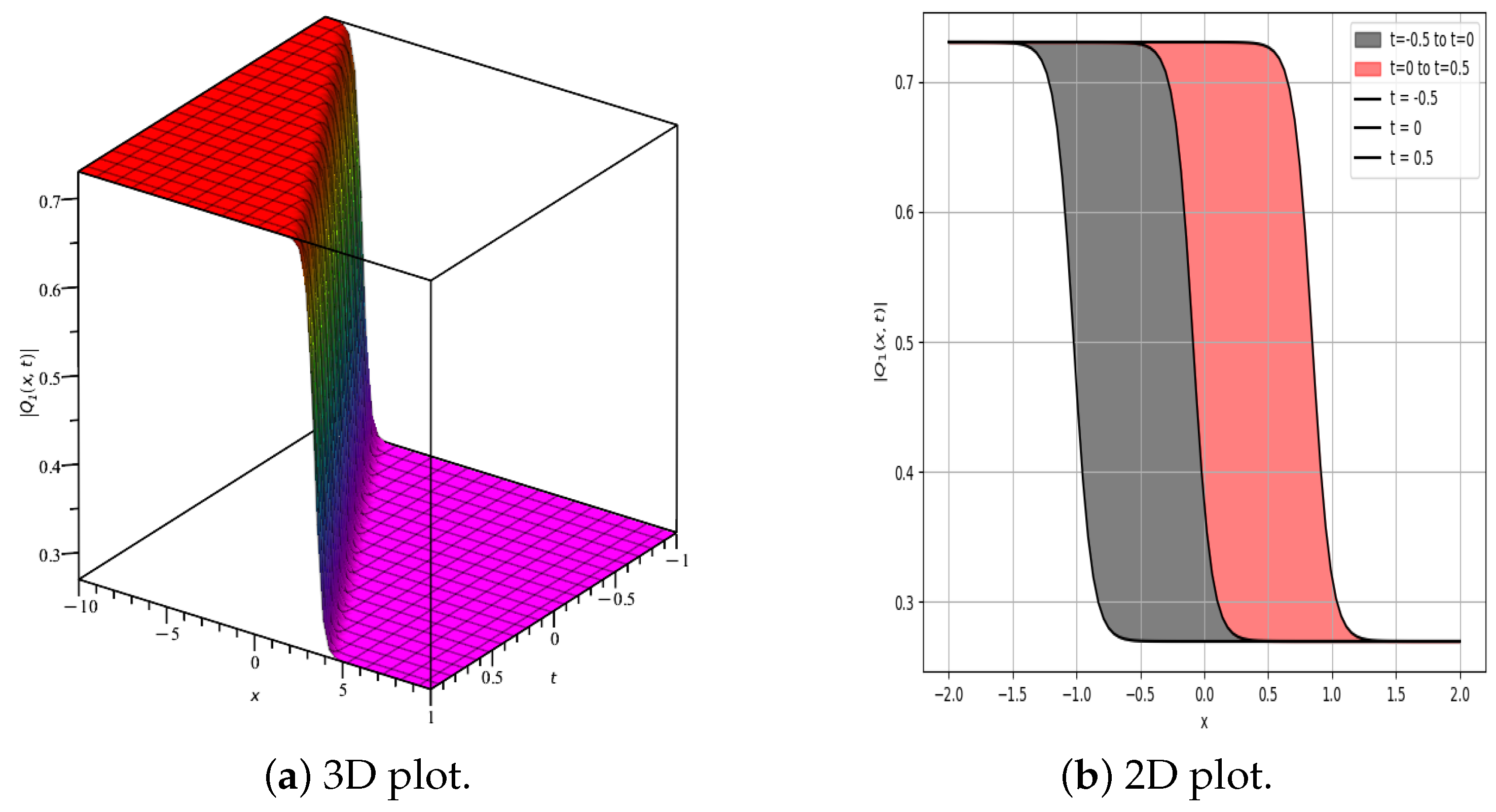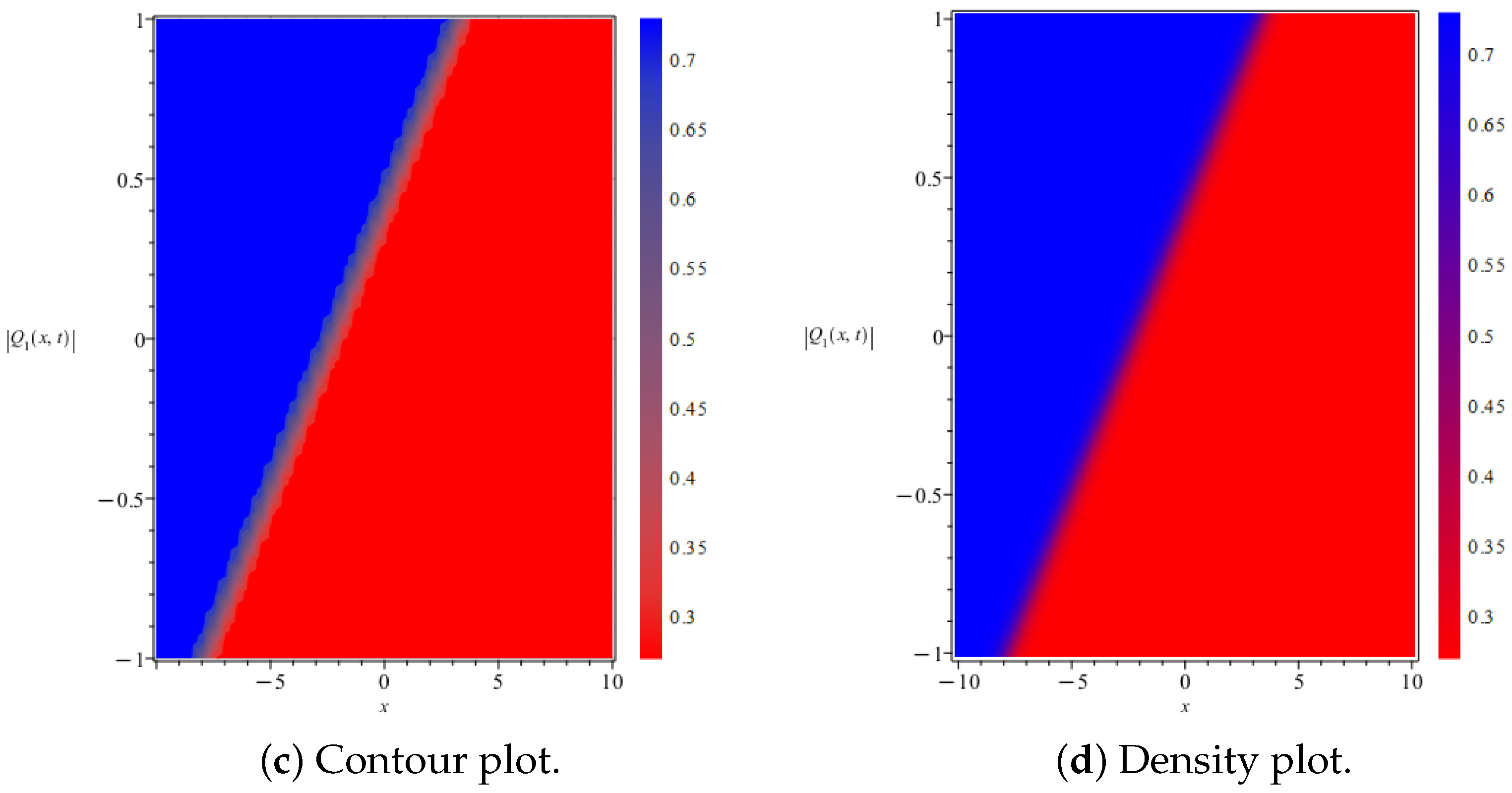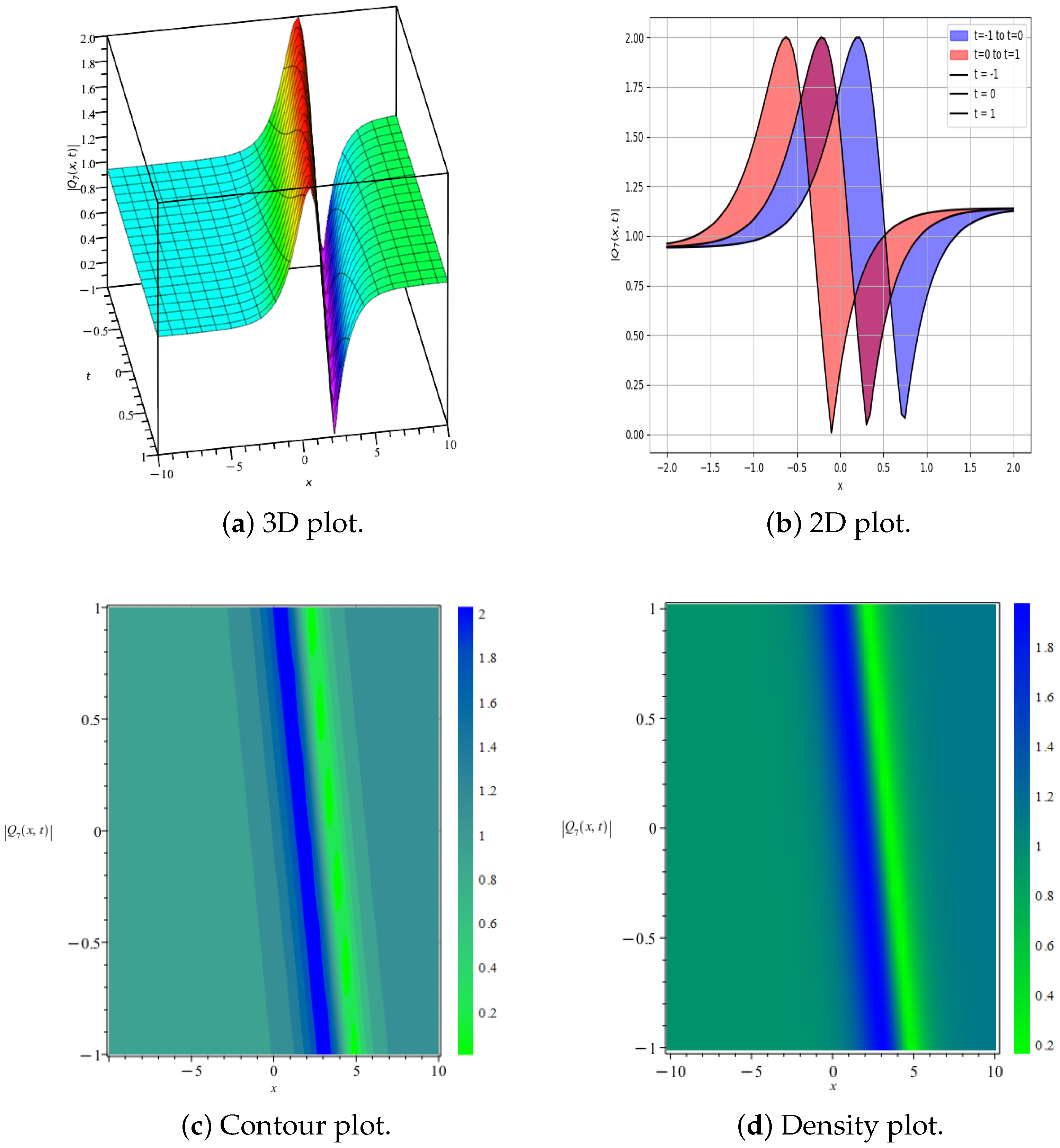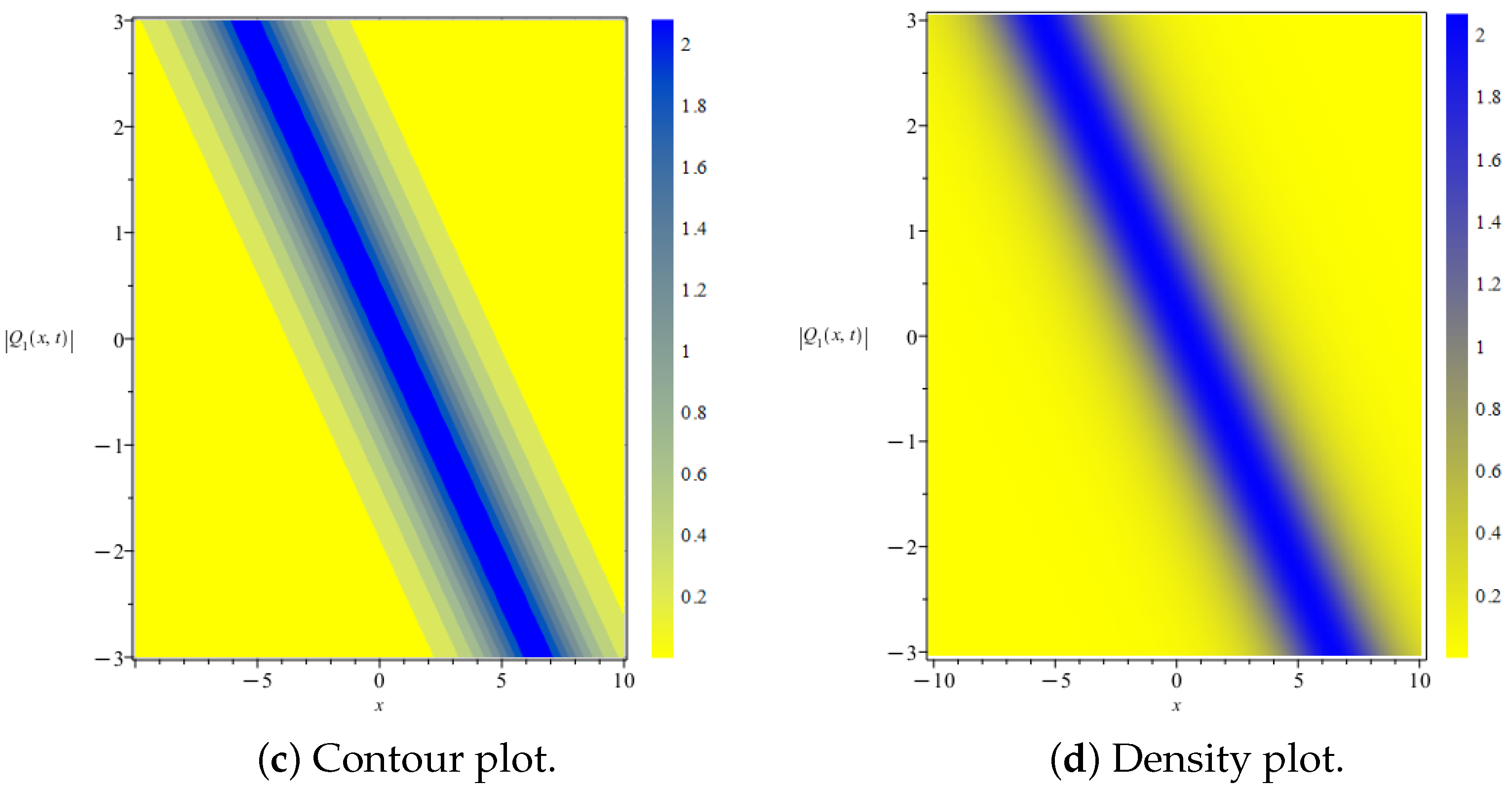Soliton Dynamics of the Nonlinear Kodama Equation with M-Truncated Derivative via Two Innovative Schemes: The Generalized Arnous Method and the Kudryashov Method
Abstract
1. Introduction
2. Preliminary
2.1. Mathematical Formulation of M-Truncated Fractional Derivative
- (i)
- ;
- (ii)
- ;
- (iii)
- ;
- (iv)
- ;
- (v)
- .
2.2. Traveling Wave Transformation and Reduction of Governing Model
3. Generalized Arnous Method
- Step 01: The (GA) method provides the solution of Equation (15), as follows:
- Step 03: After inserting Equations (17) and (20) into Equation (15) and since , as a result of this substitution, we get a polynomial of . Equivalently, all terms with the same power are set equal to zero. Then, by solving this set of nonlinear algebraic systems and with the help of Equations (17) and (9), the solutions of Equation (1) can be determined.
SolitaryWave Solution by Generalized Arnous Method
- Set 1.
- Set 2.
- Set 3.
- Set 4.
4. Formulation of New Kudryashov Method
- Step 01: The NK method constructs the solution of Equation (15) as
- Step 03: After inserting Equation (37) into Equation (15) and since , as a result of this substitution, we get a polynomial of . Equivalently, all terms with the same power are set equal to zero. Then, by solving this set of nonlinear algebraic systems and with the help of Equation (37) and Equation (9), the solutions of Equation (1) can be determined.
Solution by New Kudryashov Method
- Set 1:
- Set 2:
5. Results and Discussion
6. Conclusions
Author Contributions
Funding
Data Availability Statement
Conflicts of Interest
References
- Wang, K.J.; Li, M. Variational Principle of the Unstable Nonlinear Schrödinger Equation with Fractal Derivatives. Axioms 2025, 14, 376. [Google Scholar] [CrossRef]
- Xie, X.R.; Zhang, R.F. Neural network-based symbolic calculation approach for solving the Korteweg–de Vries equation. Chaos Solitons Fractals 2025, 194, 116232. [Google Scholar] [CrossRef]
- Bas, U.; Akkurt, A.; Has, A.; Yildirim, H. Multiplicative Riemann–Liouville fractional integrals and derivatives. Chaos Solitons Fractals 2025, 196, 116310. [Google Scholar] [CrossRef]
- Ehsan, H.; Jhangeer, A.; Říha, L. Dynamical analysis of fractional-order DNA double chain model using chaotic approach and data points. Nonlinear Dyn. 2025, 110, 18745–18769. [Google Scholar] [CrossRef]
- Xu, J.; Cui, Y.; Rui, W. Innate Character of Conformable Fractional Derivative and Its Effects on Solutions of Differential Equations. Math. Methods Appl. Sci. 2025; in press. [Google Scholar] [CrossRef]
- Murad, M.A. Optical solutions to conformable nonlinear Schrödinger equation with cubic–quintic–septimal in weakly nonlocal media by new Kudryashov approach. Mod. Phys. Lett. B 2024, 38, 2550063. [Google Scholar]
- Alazman, I.; Alkahtani, B.S.; Mishra, M.N. Dynamic of bifurcation, chaotic structure, and multi-soliton of fractional nonlinear Schrödinger equation arise in plasma physics. Sci. Rep. 2024, 14, 25781. [Google Scholar] [CrossRef]
- Li, Z.; Hussain, E. Qualitative analysis and traveling wave solutions of a (3+1)-dimensional generalized nonlinear Konopelchenko-Dubrovsky-Kaup-Kupershmidt system. Fractal Fract. 2025, 9, 285. [Google Scholar] [CrossRef]
- Ali, A.; Senu, N.; Wahi, N.; Almakayeel, N.; Ahmadian, A. An adaptive algorithm for numerically solving fractional partial differential equations using Hermite wavelet artificial neural networks. Commun. Nonlinear Sci. Numer. Simul. 2024, 137, 108121. [Google Scholar] [CrossRef]
- Mohammed, W.W.; Iqbal, N.; Sidaoui, R.; Ali, E.E. Dynamical behavior of the fractional nonlinear Kadoma equation in plasma physics and optics. Mod. Phys. Lett. B 2025, 39, 2450434. [Google Scholar] [CrossRef]
- Abdel-Salam, E.A.; Yousif, E.A.; El-Aasser, M.A. Analytical solution of the space-time fractional nonlinear Schrödinger equation. Rep. Math. Phys. 2016, 77, 19–34. [Google Scholar] [CrossRef]
- Tian, G.; Meng, X. Exact Solutions to Fractional Schrödinger–Hirota Equation Using Auxiliary Equation Method. Axioms 2024, 13, 663. [Google Scholar] [CrossRef]
- Hussain, A.; Jhangeer, A.; Tahir, S.; Chu, Y.M.; Khan, I.; Nisar, K.S. Dynamical behavior of fractional Chen–Lee–Liu equation in optical fibers with beta derivatives. Results Phys. 2020, 18, 103208. [Google Scholar] [CrossRef]
- Klein, C.; Saut, J.C.; Wang, Y. On the modified fractional Korteweg–de Vries and related equations. Nonlinearity 2022, 35, 1170. [Google Scholar] [CrossRef]
- Inc, M.; Parto-Haghighi, M.; Akinlar, M.A.; Chu, Y.M. New numerical solutions of fractional-order Korteweg–de Vries equation. Results Phys. 2020, 19, 103326. [Google Scholar] [CrossRef]
- Li, Z. Optical Solutions of the Nonlinear Kodama Equation with the M-Truncated Derivative via the Extended (G’/G)-Expansion Method. Fractal Fract. 2025, 9, 300. [Google Scholar] [CrossRef]
- Algolam, M.S.; Ahmed, A.I.; Alshammary, H.M.; Mansour, F.E.; Mohammed, W.W. The Impact of Standard Wiener Process on the Optical Solutions of the Stochastic Nonlinear Kodama Equation Using Two Different Methods. J. Low Freq. Noise Vib. Act. Control 2024, 43, 1939–1952. [Google Scholar] [CrossRef]
- Obeidat, S.T.; Rizk, D.; Mohammed, W.W.; Elmandouh, A. Bifurcation analysis and stochastic optical solutions to the stochastic nonlinear Kodama equation in nonlinear optics. AIMS Math. 2025, 10, 11111–11130. [Google Scholar] [CrossRef]
- Hosseini, K.; Alizadeh, F.; Hinçal, E.; Baleanu, D.; Akgül, A.; Hassan, A.M. Lie symmetries, bifurcation analysis, and Jacobi elliptic function solutions to the nonlinear Kodama equation. Results Phys. 2023, 54, 107129. [Google Scholar] [CrossRef]
- Akram, G.; Sadaf, M.; Zainab, I. Observations of fractional effects of β-derivative and M-truncated derivative for space time fractional Phi-4 equation via two analytical techniques. Chaos Soliton Fractals 2022, 154, 111645. [Google Scholar] [CrossRef]
- Vanterler, J.; Sousa, D.A.C.; Capelas, E.; Oliveira, D.E. A new truncated M-fractional derivative type unifying some fractional derivative types with classical properties. Int. J. Anal. Appl. 2018, 16, 83–96. [Google Scholar]
- Yao, S.W.; Manzoor, R.; Zafar, A.; Inc, M.; Abbagari, S.; Houwe, A. Exact soliton solutions to the Cahn–Allen equation and Predator–Prey model with truncated M-fractional derivative. Results Phys. 2022, 37, 105455. [Google Scholar] [CrossRef]
- Hussain, E.; Malik, S.; Yadav, A.; Shah, S.A.; Iqbal, M.A.; Ragab, A.E.; Mahmoud, H.M. Qualitative analysis and soliton solutions of nonlinear extended quantum Zakharov–Kuznetsov equation. Nonlinear Dyn. 2024, 112, 19295–19310. [Google Scholar] [CrossRef]
- Bhan, C.; Karwasra, R.; Malik, S.; Kumar, S.; Arnous, A.H.; Shah, N.A. Bifurcation, chaotic behavior and soliton solutions to the KP-BBM equation through new Kudryashov and generalized Arnous methods. AIMS Math. 2024, 9, 8749–87674. [Google Scholar] [CrossRef]







Disclaimer/Publisher’s Note: The statements, opinions and data contained in all publications are solely those of the individual author(s) and contributor(s) and not of MDPI and/or the editor(s). MDPI and/or the editor(s) disclaim responsibility for any injury to people or property resulting from any ideas, methods, instructions or products referred to in the content. |
© 2025 by the authors. Licensee MDPI, Basel, Switzerland. This article is an open access article distributed under the terms and conditions of the Creative Commons Attribution (CC BY) license (https://creativecommons.org/licenses/by/4.0/).
Share and Cite
Farooq, K.; Tedjani, A.H.; Li, Z.; Hussain, E. Soliton Dynamics of the Nonlinear Kodama Equation with M-Truncated Derivative via Two Innovative Schemes: The Generalized Arnous Method and the Kudryashov Method. Fractal Fract. 2025, 9, 436. https://doi.org/10.3390/fractalfract9070436
Farooq K, Tedjani AH, Li Z, Hussain E. Soliton Dynamics of the Nonlinear Kodama Equation with M-Truncated Derivative via Two Innovative Schemes: The Generalized Arnous Method and the Kudryashov Method. Fractal and Fractional. 2025; 9(7):436. https://doi.org/10.3390/fractalfract9070436
Chicago/Turabian StyleFarooq, Khizar, Ali. H. Tedjani, Zhao Li, and Ejaz Hussain. 2025. "Soliton Dynamics of the Nonlinear Kodama Equation with M-Truncated Derivative via Two Innovative Schemes: The Generalized Arnous Method and the Kudryashov Method" Fractal and Fractional 9, no. 7: 436. https://doi.org/10.3390/fractalfract9070436
APA StyleFarooq, K., Tedjani, A. H., Li, Z., & Hussain, E. (2025). Soliton Dynamics of the Nonlinear Kodama Equation with M-Truncated Derivative via Two Innovative Schemes: The Generalized Arnous Method and the Kudryashov Method. Fractal and Fractional, 9(7), 436. https://doi.org/10.3390/fractalfract9070436






